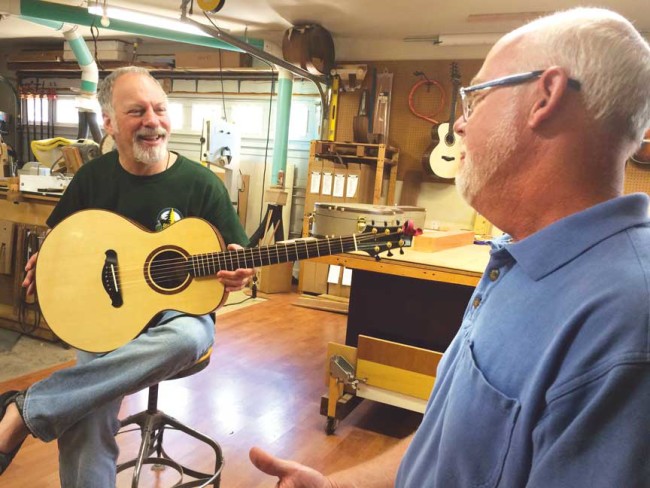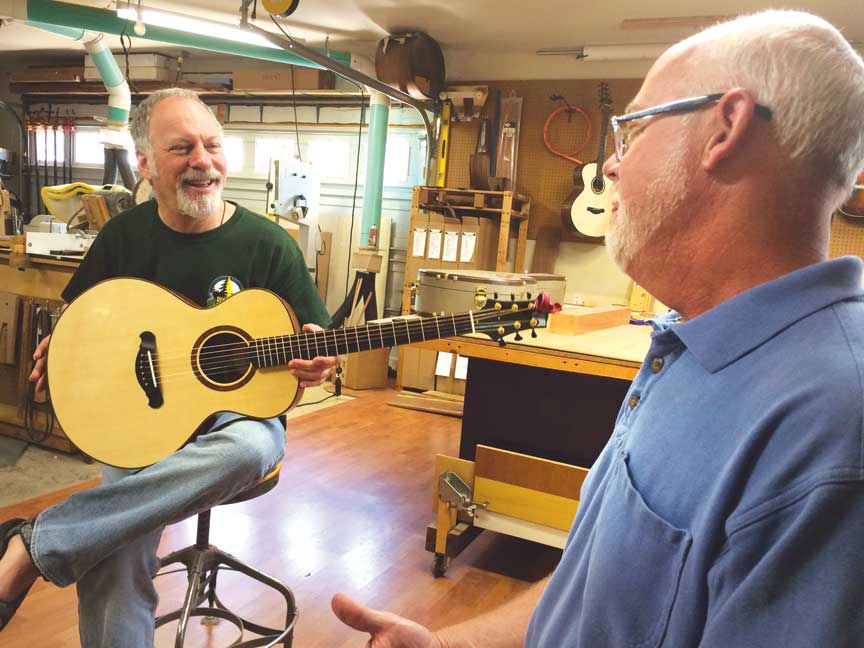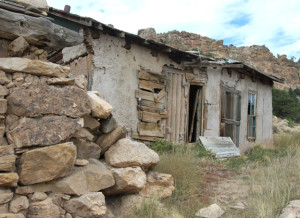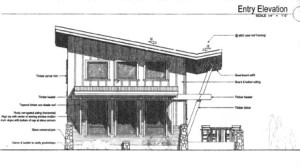by Mike Rosso
Although he professes to be “just a toolmaker,” Salida-based luthier Jeff Bamburg is hand-crafting some of the finest steel-string guitars in North America. A builder for just ten years, his instruments are garnishing high praise from around the U.S. and the world.
Bamburg first caught the guitar bug while listening to recordings of finger-style guitar pickers such as Leo Kottke. “I wanted to play guitar, I liked finger-style guitar music, it was kind of my first love.” He was particularly inspired by the flat-picking instrumental by the late John Denver: Late Winter, Early Spring.
“About 15-16 years ago I thought, I’m going to buy a nice guitar and learn to play.” He had no idea about price ranges and thought he could spend about five hundred bucks to buy a top-of-the-line guitar,” … and so my education began,” he says with a grin.
Living in Portland, Oregon at the time, Bamburg saw the light and bought a Breedlove Ed Gerhard Signature Model guitar for around $2,800, but it was a video produced by Windham Hill Records founder Will Ackerman entitled “Modern Luthier” that sparked his interest in lutherie. In that video, Ackerman interviewed several guitar builders, including Breedlove.
“I thought, that’d be neat to try someday.” This from a guy whose only woodworking experience up until then was the construction of a doghouse as a teenager. Six years later he purchased a guitar kit. “That first guitar turned out to be nothing. It’s never had strings on it. It was a learning process.” By his third guitar, he finally decided to string it up. Then it was game on.
A printer by trade, Jeff and his wife Victoria moved to Salida in 2007, at which time he decided to pursue guitar-building full time. “Its kind of a harsh environment for guitar-building, which is why I keep the shop humidified.” Building guitars at about 45-50 percent relative humidity is optimal, he says.

His goal was to build a modern, more responsive style of guitar as compared to the traditional Martin and Gibson designs. He strives to make his guitars balanced from bass to treble with a good midrange, and all of the strings present so that the guitar can hold up as a solo instrument. His goal is to have a plucked string at the 12th fret to ring with the same clarity as that same string fretted at the first fret.
What sets a Bamburg guitar apart from the field? For one, the shape of his guitars: at the waist they are a little tighter than traditional ones. Also the upper bout is a little smaller to fit the lap when playing in seated position. In construction and design he goes for volume, clarity and evenness of tone – what he calls “that sound in my head,” likening it to the sound of the human voice. He looks for clear trebles and “piano-like” bass notes. “There’s some art, there’s some science, there’s some romance and mystery here, and there’s some luck. But if I could zero in on that, it would sure help!” said Bamburg in a video produced for a London guitar dealer.
Bamburg likes to build with various Rosewood back and sides paired with many different species of spruce tops. Wood choices depend on the player’s tonal and aesthetic preferences. “Indian rosewood and Sitka spruce are the standbys,” he says. But he might also use Romanian Carpathian spruce as well. Dense woods such as Cocobolo are very reflective, so they give a lot of overtone and sustain. Mahogany is the primary choice for necks.
[InContentAdTwo]
He experiments with Chladni patterns, which use a sine wave generator to drive the guitar tops using glitter to indicate a resonant frequency. A cantilevered neck design results in a very level fingerboard. Two carbon rods on each side of the truss rod in the neck add stiffness, “turning the neck into an I-beam,” he says. The trim accents on his instruments are simple but sublime. “There’s not a lot of dead shellfish on there,” he joked, referring to the use of abalone and pearl inlay found on many upscale guitars. Bamburg likes to maintain the natural color of the wood but will add a little stain to help in the transition areas, such as where the neck meets the body. He uses a UV curable polyester finish at about 3.5 to 4 mils thick. He is currently building about ten custom instruments per year.
Bamburg first began selling his products on consignment through a dealer in Santa Fe and then began displaying his wares at international guitar shows. To date, he’s built 58 working guitars and currently builds almost strictly on commission. About 70 percent are for clients and 30 percent on spec. His website also draws much traffic and potential customers. His custom guitars have shipped to places such as New York, Georgia, and Dallas, Texas, as well as a high-end guitar dealer in London, England: The North American Guitar Company, who discovered his work at a trade show and immediately signed him up. Bamburg guitars are also owned and played by notable Colorado-based musicians Jonah Werner and Jaquie Gipson.
The current models come in five body sizes: a small jumbo with a 16-inch lower bout, the JSB; a 15-inch lower bout, the FSC or Fireside Concert; the 17-inch jumbo JB; the Fan Fret, FF; and the JB-B baritone. The base price for all models is $7,000, and he offers a variety of tailor-made features such as side ports, arm bevels and custom inlays. Bamburg likes to visit with each potential buyer to observe and listen to their playing style to help customize the instrument to their specific needs and wants.
Bamburg is now looking to expand his operation with the creation of the Rocky Mountain Guitar Co., a separate entity that will produce and offer a semi-production model or “artists’ series.” Though not fully custom-built, they will have the same craftsmanship and quality of the custom models, and will possibly incorporate regional woods from the Rocky Mountains, such as Engelmann spruce. Three initial models are currently being demoed by players to get feedback on design and playability.
If you are serious about a new guitar and don’t have a problem tapping into your offspring’s inheritance, a Bamburg guitar is certainly worth a look … and a listen.
www.bamburgguitars.com
www.thenorthamericanguitar.com/bamburg





